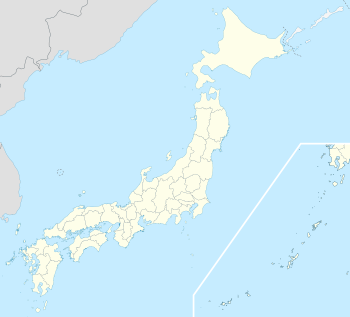Railway Technical Research Institute: Difference between revisions
m robot Modifying: zh:鐵道綜合技術研究所 |
m General clean of pages with portal flags using AWB |
||
| Line 2: | Line 2: | ||
|name = Railway Technical Research Institute</br>財団法人鉄道総合技術研究所 |
|name = Railway Technical Research Institute</br>財団法人鉄道総合技術研究所 |
||
|image = JR logo RTRI.svg |
|image = JR logo RTRI.svg |
||
|image_border = |
|image_border = |
||
|size = 100px |
|size = 100px |
||
|alt = <!-- alt text; see [[WP:ALT]] --> |
|alt = <!-- alt text; see [[WP:ALT]] --> |
||
| Line 11: | Line 11: | ||
|mcaption = <!-- optional --> |
|mcaption = <!-- optional --> |
||
|abbreviation = RTRI |
|abbreviation = RTRI |
||
|motto = |
|motto = |
||
|formation = {{Start date and years ago|1986|12|10}} |
|formation = {{Start date and years ago|1986|12|10}} |
||
|extinction = <!-- date of extinction, optional --> |
|extinction = <!-- date of extinction, optional --> |
||
| Line 21: | Line 21: | ||
|coords = <!-- Coordinates of location using a coordinates template --> |
|coords = <!-- Coordinates of location using a coordinates template --> |
||
|region_served = Japan |
|region_served = Japan |
||
|membership = |
|membership = |
||
|language = Japanese |
|language = Japanese |
||
|leader_title = <!-- position title for the leader of the org --> |
|leader_title = <!-- position title for the leader of the org --> |
||
| Line 36: | Line 36: | ||
[[Image:Railway technical research institute in japan.jpg|thumb|right|Railway Technical Research Institute in [[Kokubunji]], [[Tokyo]]]] |
[[Image:Railway technical research institute in japan.jpg|thumb|right|Railway Technical Research Institute in [[Kokubunji]], [[Tokyo]]]] |
||
{{Nihongo|'''Railway Technical Research Institute'''|鉄道総合技術研究所|Tetsudō Sōgō Gijutsu Kenkyūsho}}, or {{Nihongo|'''RTRI'''|鉄道総研|Tetsudō Sōken}}, is the technical research company under the [[Japan Railways]] group of companies. |
{{Nihongo|'''Railway Technical Research Institute'''|鉄道総合技術研究所|Tetsudō Sōgō Gijutsu Kenkyūsho}}, or {{Nihongo|'''RTRI'''|鉄道総研|Tetsudō Sōken}}, is the technical research company under the [[Japan Railways]] group of companies. |
||
== Overview == |
== Overview == |
||
| Line 48: | Line 48: | ||
== Main office and branch office == |
== Main office and branch office == |
||
{{Location map+|Japan|float=right|width=350|places= |
{{Location map+|Japan|float=right|width=350|places= |
||
{{Location map~|Japan|label=<!--Shinjuku--> |lat_deg=35|lat_min=41|lat_sec=20|lon_deg=139|lon_min=41|lon_sec=59|mark=Blue pog.svg |position=top}} |
{{Location map~|Japan|label=<!--Shinjuku--> |lat_deg=35|lat_min=41|lat_sec=20|lon_deg=139|lon_min=41|lon_sec=59|mark=Blue pog.svg |position=top}} |
||
{{Location map~|Japan|label=<!--Tokyo--> |lat_deg=35|lat_min=40|lat_sec=35|lon_deg=139|lon_min=45|lon_sec=43|mark=Blue pog.svg |position=right}} |
{{Location map~|Japan|label=<!--Tokyo--> |lat_deg=35|lat_min=40|lat_sec=35|lon_deg=139|lon_min=45|lon_sec=43|mark=Blue pog.svg |position=right}} |
||
| Line 62: | Line 62: | ||
* Wind Tunnel Technical Center |
* Wind Tunnel Technical Center |
||
* Shiozawa Snow Testing Station |
* Shiozawa Snow Testing Station |
||
* Hino Civil Engineering Testing Station |
* Hino Civil Engineering Testing Station |
||
* Gatsugi Anti-Salt Testiong Station |
* Gatsugi Anti-Salt Testiong Station |
||
| Line 79: | Line 79: | ||
* [[Hydrail]] |
* [[Hydrail]] |
||
== |
==External links== |
||
* [http://www.rtri.or.jp/ RTRI Website] |
* [http://www.rtri.or.jp/ RTRI Website] |
||
== |
==References== |
||
{{ |
{{Commons category|Railway Technical Research Institute(Japan)}} |
||
{{ |
{{Reflist}} |
||
{{Companies |
{{Portal|Companies}} |
||
{{JR}} |
{{JR}} |
||
[[Category:Rail transport in Japan]] |
[[Category:Rail transport in Japan]] |
||
{{japan-rail-company-stub}} |
{{japan-rail-company-stub}} |
||
Revision as of 18:47, 1 June 2010
 RTRI's logo | |
| Abbreviation | RTRI |
|---|---|
| Formation | December 10, 1986 |
| Type | Japanese Foundation |
| Purpose | Research and consulting of the railway technology. |
| Headquarters | 2-8-38, Hikaricho, Kokubunji-shi, Tokyo |
| Location | |
Region served | Japan |
Official language | Japanese |
| Leader | Eisuke Masada (正田 英介) chairperson |
| Affiliations | Japan Railways Group |
Budget | 15.3 billion YEN (FY 2009) [1] |
Staff | 512 (as of October 1, 2008) |
| Website | www.rtri.or.jp |

Railway Technical Research Institute (鉄道総合技術研究所, Tetsudō Sōgō Gijutsu Kenkyūsho), or RTRI (鉄道総研, Tetsudō Sōken), is the technical research company under the Japan Railways group of companies.
Overview
RTRI was established in its current form in 1986 when the Japanese National Railways was privatised and split into separate JR group companies. RTRI conducts research about everything related to trains, railways and their operation. Funding is received from the government as well as the private railway companies. RTRI works both on developing new railway technology, such as magnetic levitation, and improving the safety and economy of current technology.
Research topics include earthquake detection and alarm systems, systems for detecting obstacles on level crossings, improving adhesion between train wheels and tracks, reducing energy usage, noise barriers and preventing vibrations, among other topics.

RTRI is the main developer behind the Japanese Maglev train.
Main office and branch office
- Research facilities
- Kunitachi Institute - 2-8-38 Hikari-cho, Kokubunji-shi, Tokyo, 185-8540, Japan
- Wind Tunnel Technical Center
- Shiozawa Snow Testing Station
- Hino Civil Engineering Testing Station
- Gatsugi Anti-Salt Testiong Station
- Office
- Tokyo - 844 Shin-Kokusai Bldg. 3-4-1 Marunouchi, Chiyoda-ku, Tokyo 100-0005, Japan
- Shinjuku
Gauge Change Train
The RTRI is developing a variable gauge system, called the "Gauge Change Train", to allow 1435 Shinkansen trains to access 1067 lines of the original rail network.[2]
Publications
See also
External links
References

